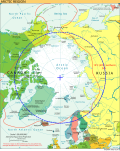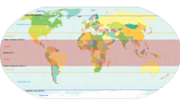 | In astronomy, axial tilt, also known as obliquity, is the angle between an object's rotational axis and its orbital axis, which is the line perpendicular... 33 KB (3,100 words) - 07:23, 1 May 2024 |
 | Earth (section Axial tilt and seasons) equinox dates swapped. The angle of Earth's axial tilt is relatively stable over long periods of time. Its axial tilt does undergo nutation; a slight, irregular... 219 KB (19,284 words) - 01:32, 7 May 2024 |
Season (section Axial tilt) a given region. On Earth, seasons are the result of the axial parallelism of Earth's tilted orbit around the Sun. In temperate and polar regions, the... 58 KB (6,423 words) - 04:42, 4 April 2024 |
 | Milankovitch cycles (section Axial tilt (obliquity)) Milanković. In the 1920s, he hypothesized that variations in eccentricity, axial tilt, and precession combined to result in cyclical variations in the intra-annual... 49 KB (5,188 words) - 00:50, 30 April 2024 |
 | Ceres (dwarf planet) (section Rotation and axial tilt) equatorial crater of Kait is selected as its prime meridian. Ceres has an axial tilt of 4°, small enough for its polar regions to contain permanently shadowed... 129 KB (12,698 words) - 21:04, 5 May 2024 |
 | Retrograde and prograde motion (section Axial tilt) retrograde orbit. A celestial object's axial tilt indicates whether the object's rotation is prograde or retrograde. Axial tilt is the angle between an object's... 40 KB (4,640 words) - 20:29, 3 March 2024 |
 | Planet (section Axial tilt) the planet. Jupiter's axial tilt is very small, so its seasonal variation is minimal; Uranus, on the other hand, has an axial tilt so extreme it is virtually... 195 KB (20,575 words) - 05:22, 26 April 2024 |
 | Uranus (redirect from Tilt of Uranus) (−224 °C; −371 °F) out of all the Solar System's planets. It has a marked axial tilt of 82.23° with a retrograde rotation period of 17 hours and 14 minutes... 154 KB (15,171 words) - 06:01, 6 May 2024 |
 | ecliptic, the plane in which the Earth orbits around the Sun. Earth's axial tilt varies over a 41,000-year period from about 22.1 to 24.5 degrees, and... 14 KB (1,171 words) - 20:18, 25 April 2024 |
 | planet's axial tilt, i.e. its obliquity against the orbit around the star. On Earth, the Moon has played an important role in stabilizing the axial tilt of... 37 KB (3,721 words) - 03:57, 3 May 2024 |
 | projection of the terrestrial equator into outer space. Due to Earth's axial tilt, the celestial equator is currently inclined by about 23.44° with respect... 5 KB (441 words) - 13:20, 19 March 2024 |
axial tilt to be captured in a resonance called a Cassini state. There are small oscillations around this state and in the case of Mars these axial tilt... 55 KB (6,471 words) - 14:06, 23 March 2024 |
 | Sun path (section Effect of the Earth's axial tilt) determined from basic geometry.[unreliable source?] The Earth's axis of rotation tilts about 23.5 degrees, relative to the plane of Earth's orbit around the Sun... 16 KB (2,376 words) - 02:45, 16 April 2024 |
suggested that the Moon is necessary to keep the Earth's axial tilt stable. Without the Moon the axial tilt of Earth could therefore oscillate chaotically from... 10 KB (1,018 words) - 16:55, 12 April 2024 |
 | axial tilt (that is, of the Earth's axis of daily rotation relative to the ecliptic, the plane of the Earth's orbit). This predominant, average tilt of... 5 KB (656 words) - 20:07, 22 January 2024 |
 | slightly over cycles of varying lengths (see nutation, polar motion and axial tilt). Finally, over very long periods the positions of the stars themselves... 10 KB (1,159 words) - 04:28, 7 March 2024 |
intended to determine the Earth's axial tilt ("obliquity of the ecliptic") to high precision. He determined the axial tilt to be 23°32'19" for the year 994... 4 KB (486 words) - 13:14, 20 June 2023 |
 | any long period or cycle, such as the Great Year. Due to the Earth's axial tilt, the course of a year sees the passing of the seasons, marked by change... 51 KB (5,661 words) - 01:31, 17 April 2024 |
 | Circumbinary planet (section Axial tilt precession) with the mutual inclinations of planets in multi-planetary systems. The axial tilt of Kepler-413b's spin axis might vary by as much as 30 degrees over 11... 47 KB (5,040 words) - 05:02, 6 April 2024 |
 | 21 Lutetia (section Shape and axial tilt) rotational pole of Lutetia: RA = 51.8°±0.4°, Dec = +10.8°±0.4°. This gives an axial tilt of 96° (retrograde rotator), meaning that the axis of rotation is approximately... 25 KB (2,367 words) - 03:59, 4 May 2024 |
 | next 1.5–4.5 billion years, Earth's axial tilt may begin to undergo chaotic variations, with changes in the axial tilt of up to 90°. The luminosity of the... 98 KB (10,921 words) - 10:48, 3 May 2024 |








